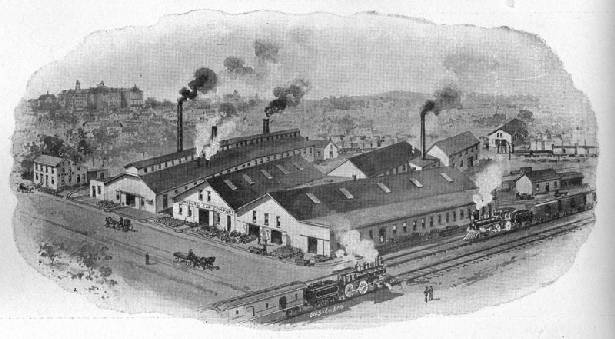Bloomsburg Car Manufacturing Company
About 1871, under the name of the Columbia County Iron Manufacturing Company, (or Columbia County Iron & Manufacturing Company) it began to build small mine cars. About this time George M. Lockard (c1835-1880+) became foreman of the wood department, and the next year he and John K. Lockard (c1847-1880+) [reportedly a cousin] bought a quarter interest in the firm. The two had been employees of the Jackson & Woodin Manufacturing Company, a railway car building firm in nearby Berwick. George Lockard had learned the carpenter’s trade from his father, then attended the academy (equivalent to high school) at New Columbus, Luzerne Co., Pennsylvania. He then taught school during winters for five terms, and for about five years owned and operated a boat on the canal. In 1861 or 1862 he had resumed his trade, now in the employ of Jackson & Woodin. John Lockard had been raised on the farm, then learned the carpenter’s trade and went directly to work for Jackson & Woodin. The company the Lockards had bought into failed in 1873, apparently a casualty of the financial panic that occurred that year and the ensuing depression. What happened next is not completely clear. It appears that Mordecai W. Jackson—one of the owners of Jackson & Woodin—bought the firm and employed the two Lockards. In 1875 they “took possession” of the firm (whatever that means). And in 1879 they bought out his interest and became the sole owners. That same year the buildings of the plant were totally destroyed by fire with a loss of $40,000, and only $18,000 of insurance. Using the insurance proceeds and with what machinery they could recover, the Lockards rebuilt the plant within three months and with three times the capacity. During the next four years they built more than 4,000 twenty-ton railroad cars in addition to other work. They did about $1 million in business per year and employed 200 to 250 men with a payroll of about $10,000 per month.{38} After 1883, their business consisted mainly of building mining cars and producing car wheels, mining supplies, etc., averaging about $100,000 per annum, and employing 40 to 50 men.(38) (Seems like quite a come-down, but that's what the source says.)
The firm was reorganized in November 1894 and renamed the Bloomsburg Car Manufacturing Company, and the capital stock was increased from $50,000 to $200,000. The firm concentrated on making freight, mine, and rotary dump cars as well as car wheels. About 1898, Bloomsburg was one of the companies trying to produce a simplified truck for freight cars. It manufactured a truck designed by R.W. Oswald which it marketed as the “Black Diamond” truck. This truck—made largely of angle iron—was ungainly in appearance and appears to have been little used despite coming from an established car builder. In 1899, Bloomsburg was one of the 13 companies that were consolidated into the American Car & Foundry Company, but it apparently continued to do business under its own name, as it is listed under “Car Builders” in the New York City section of White-Orr's 1930 Classified Business Directory. The Bloomsburg Daily in 1902 described the company as having a large export business with markets in Cuba, South America, South Africa, and China. By the start of the 1st World War, the company had a capacity of 2,000 freight and 3,000 mine cars annually. A fire destroyed the entire factory on 26 August 1930. American Car & Foundry did not rebuild the factory due to the national depression and the presence of its huge nearby Berwick plant. |
